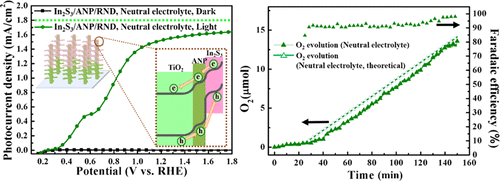当前位置:
X-MOL 学术
›
ACS Appl. Mater. Interfaces
›
论文详情
Our official English website, www.x-mol.net, welcomes your feedback! (Note: you will need to create a separate account there.)
Toward Eco-Friendly and Highly Efficient Solar Water Splitting Using In2S3/Anatase/Rutile TiO2 Dual-Staggered-Heterojunction Nanodendrite Array Photoanode
ACS Applied Materials & Interfaces ( IF 9.5 ) Pub Date : 2018-01-16 00:00:00 , DOI: 10.1021/acsami.7b19139 Jih-Sheng Yang,Jih-Jen Wu
ACS Applied Materials & Interfaces ( IF 9.5 ) Pub Date : 2018-01-16 00:00:00 , DOI: 10.1021/acsami.7b19139 Jih-Sheng Yang,Jih-Jen Wu

|
The TiO2-based heterojunction nanodendrite (ND) array composed of anatase nanoparticles (ANPs) on the surface of the rutile ND (RND) array is selected as the model photoanode to demonstrate the strategies toward eco-friendly and efficient solar water splitting using neutral electrolyte and seawater. Compared with the performances in alkaline electrolyte, a non-negligible potential drop across the electrolyte as well as impeded charge injection and charge separation is monitored in the ANP/RND array photoanode with neutral electrolyte, which are, respectively, ascribed to the series resistance of neutral electrolyte, the fundamentally pH-dependent water oxidation mechanism on TiO2 surface, as well as the less band bending at the interface of TiO2 and neutral electrolyte. Accordingly, a TiO2-based dual-staggered heterojunction ND array photoanode is further designed in this work to overcome the issue of less band bending with the neutral electrolyte. The improvement of charge separation efficiency is realized by the deposition of a transparent In2S3 layer on the ANP/RND array photoanode for constructing additional staggered heterojunction. Under illumination of AM 1.5G (100 mW cm–2), the improved photocurrent densities acquired both in neutral electrolyte and seawater at 1.23 V vs reversible hydrogen electrode (RHE), which approach the theoretical value for rutile TiO2, are demonstrated in the dual-staggered-heterojunction ND array photoanode. Faradaic efficiencies of ∼95 and ∼32% for solar water oxidation in neutral electrolyte and solar seawater oxidation for 2 h are acquired at 1.23 V vs RHE, respectively.
中文翻译:

使用In 2 S 3 /锐钛矿/金红石TiO 2双交错异质结纳米枝晶阵列光电阳极实现生态友好和高效的太阳能水分解
选择金红石型ND(RND)阵列表面上由锐钛矿型纳米粒子(ANP)组成的基于TiO 2的异质结纳米枝晶(ND)阵列作为模型光阳极,以展示利用中性法实现生态友好和高效的太阳能分水的策略电解质和海水。与碱性电解液中的性能相比,在带有中性电解液的ANP / RND阵列光阳极中,监测了整个电解液中不可忽略的电势下降以及电荷注入和电荷分离受阻,这分别归因于电池的串联电阻。中性电解质,在TiO 2表面上基本依赖于pH值的水氧化机理,以及TiO 2界面处的能带弯曲较小和中性电解质。因此,在这项工作中进一步设计了基于TiO 2的双交错异质结ND阵列光电阳极,以克服中性电解质带束弯曲较少的问题。通过在ANP / RND阵列光电阳极上沉积透明的In 2 S 3层以构建额外的交错异质结,可以实现电荷分离效率的提高。在AM 1.5G(100 mW cm –2)的光照下,与可逆氢电极(RHE)相比,在1.23 V的中性电解液和海水中获得的改善的光电流密度均接近可逆金红石TiO 2的理论值在双交错异质结ND阵列光电阳极中得到了证明。在1.23 V vs. RHE的条件下,中性电解质中的太阳能氧化和2小时的太阳能海水氧化法拉第效率分别约为95%和32%。
更新日期:2018-01-16
中文翻译:

使用In 2 S 3 /锐钛矿/金红石TiO 2双交错异质结纳米枝晶阵列光电阳极实现生态友好和高效的太阳能水分解
选择金红石型ND(RND)阵列表面上由锐钛矿型纳米粒子(ANP)组成的基于TiO 2的异质结纳米枝晶(ND)阵列作为模型光阳极,以展示利用中性法实现生态友好和高效的太阳能分水的策略电解质和海水。与碱性电解液中的性能相比,在带有中性电解液的ANP / RND阵列光阳极中,监测了整个电解液中不可忽略的电势下降以及电荷注入和电荷分离受阻,这分别归因于电池的串联电阻。中性电解质,在TiO 2表面上基本依赖于pH值的水氧化机理,以及TiO 2界面处的能带弯曲较小和中性电解质。因此,在这项工作中进一步设计了基于TiO 2的双交错异质结ND阵列光电阳极,以克服中性电解质带束弯曲较少的问题。通过在ANP / RND阵列光电阳极上沉积透明的In 2 S 3层以构建额外的交错异质结,可以实现电荷分离效率的提高。在AM 1.5G(100 mW cm –2)的光照下,与可逆氢电极(RHE)相比,在1.23 V的中性电解液和海水中获得的改善的光电流密度均接近可逆金红石TiO 2的理论值在双交错异质结ND阵列光电阳极中得到了证明。在1.23 V vs. RHE的条件下,中性电解质中的太阳能氧化和2小时的太阳能海水氧化法拉第效率分别约为95%和32%。


























 京公网安备 11010802027423号
京公网安备 11010802027423号